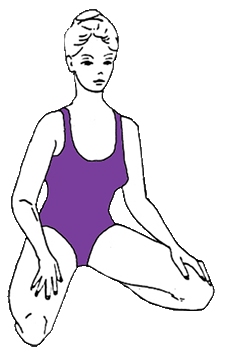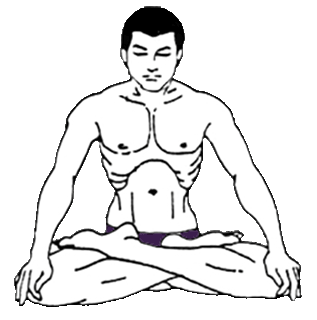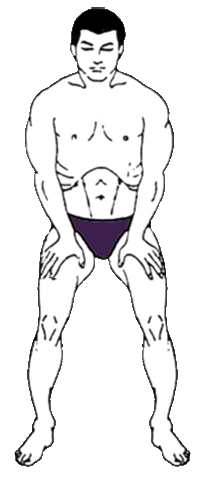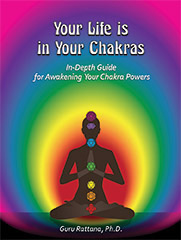Lesson 8 - Activating the Locks (Bhandas)
An Introductory Course, Designed and Written by Guru Rattana, Ph.D.
Activating the Kundalini
Each of us in our own way is unique, creative and alive. We are each born with the innate capacity to able to both master and accept our circumstances, and learn from our life challenges. If we tap into our inner powers we can accomplish much and achieve happiness and inner peace. The spiritual path is about learning to connect with our soul essence, wisely use our vital energy and discover our gifts so that we can successfully navigate our life.
Kundalini energy is this dormant potential in each of use; the internal fire that ignites our Soul and awakens our consciousness. Raising our Kundalini is about activating our internal flame, unleashing our passion for life and taming our emotions so that we can use our energy to live an elevated and fulfilling life.
The spirit of our soul is always available to us. Kundalini Yoga was created to help us:
Tap the magical powers of the Divine within
Cultivate our internal fire
Build our charismatic presence
Unleash our will to act and create in our own unique way
Transmute fear into prana and vitality
Awaken our Kundalini - the power of our Soul
The Awakening Process
How do we tap the fire, the passion, the magnetic presence and the unlimited energy that the Kundalini represents?
The boundless energy of our Soul lies dormant, ready and waiting to be awakened. The awakening process involves 3 complementary principles:
- Activation
- Allowing
- Alignment
(1) Activation is the conscious effort or the masculine aspect. Activation is associated with practicing a discipline involving techniques designed to shift energy. Activation involves some form of action or "doing."
(2) Allowing is the conscious acceptance of what is occurring. Allowing is the feminine aspect. Allowing involves simply being, 'doing nothing', but at the same time being very aware of what is happening.
(3) Alignment is the integration or the result of activation and allowing. The goal is two fold (1) to align our energy with universal energy, so that universal energy effortlessly flows through us and (2) to align our body, mind and emotions so our infinite potential is unleashed within us.
The practice of Kundalini Yoga incorporates these 3 principles.
(1) Activation takes place with the practice of asanas or yoga exercises. When it is properly functioning, the release of the energy of the Kundalini is facilitated. The power of the exercises is enhanced with the breath and the internal recitation of mantras. The exercises strengthen the nervous system, stimulate the glands to secrete, loosen up the muscles and align the skeleton. The body is the temple of the Soul.
(2) Allowing happens when we relax, let go and stop trying to make something happen. We are programmed to try to control ourselves, the events in our lives and our environments. Yet perhaps 90% of what happens within ourselves and in our lives happens beyond our control. Ideally we would spend equal time simply being aware of what is happening and tuning into the reality of what IS. By simply allowing, we not only expand our awareness of what is transpiring within about outside ourselves, we release the resistance that prevents our energy from flowing and things from happening in our lives.
(3) Alignment has both and active and a passive component. The active component involves "applying the locks" or performing subtle internal movements in the chakras and along the spine. The passive component happens naturally when the blocks in the body have been released. The physical and energy bodies automatically align when the resistance to the natural state and flow is gone.
Energy Flow
Our goal is to access, activate and increase the energy flow in our bodies. There are several ways to do this. The practice of Kundalini Yoga incorporates the following principle techniques:
- Movement or exercise which opens channels in the body and causes the glands to secrete.
- Receiving the energy contained in the breath
- Allowing our innate energy to flow by releasing resistance and blocks
- Opening ourselves to receive Divine energy by opening our chakras and our mind.
Locks or Bhandas
Locks or Bhandas create an internal posture that facilitates the activation and flow of the Kundalini. The slight movements in the muscles align the body so the energy in the spine can flow upward, not downward. Lock refers to the action performed by the locks before a dam, which prevent water, or in this case energy, from being released in a backward or downward direction. The term locks should not be interpreted as a forceful constriction. The idea is not to block the energy but to open up the spine so that the energy can flow easier and be released upward. A more gentle way to relate to the locks is to view them as ways to open up the flowers or the pedals of the lotuses along the spine.
When to Apply the Locks
Relaxing while holding a posture (after the exercise is completed), creates a dynamic space for movement of energy. In general, the locks are applied while holding the posture after completing a yoga exercise. This direction is not always specified. It assumed that the student will gently apply the appropriate locks to anchor in the internal effects of the asana.

Rootlock or Mulbhand
Practicing Rootlock grounds our attention in the lower chakras, expands our sensory awareness, and creates a sense of warmth, fullness, aliveness, and vitality. It seals the effect of an exercise and helps us contain our energy in the body.
Rootlock engages the first, second, and third chakras. Because each chakra embodies a different element, we work with them separately at first to feel how to empower that element. At the first chakra, we pulse the anus to establish our relationship with Mother Earth and to feel a stable grounded base. At the second chakra, we relax so that the fluid water energy can move and flow. At the third chakra, we stimulate the awakening of the fire energy.
Full Rootlock, or Mulbhand, engages the anus and perineum, the sex organs, and the navel point. Although not always specified, it is understood that we apply the root lock on the suspended inhale and/or the suspended exhale after an exercise. The goal of root lock is to direct subtle energies produced by the various Kundalini Yoga exercises. Root lock focuses our energy, moves it up the spine to feed our brain, and circulates the energy produced by the exercise throughout the body.
Rootlock can be applied with a variety of intensities. However, its goal is to move and direct energy, not to block it. Therefore, everyone is invited to experiment with how to use this internal positioning to create enjoyable and sensual awakenings in the spine and body.
Rootlock can be done at any time in your practice or during the day to activate the spine and third eye, to feed the brain, release tension, to dissipate depression, to become vitally alive, and to change any mood or behavior. Practice generating and releasing energy with Breath of Fire and other lower chakra exercises and then experiment with the locks. Focus at your third eye to awaken the sixth chakra.
The complete Rootlock is performed in three steps, which become almost simultaneous when each part is understood. The three aspects of Rootlock correspond to the first three chakras:
- First Chakra - Earth Element. Lightly contracting the muscles of the rectum or anal sphincter, drawing it in and up (as if trying to hold back a bowel movement).
- Second Chakra - Water Element. Drawing up the sex organ (so that the urethral tract is contracted, like trying to hold back urination).
- Third Chakra - Fire Element. Pull the navel point in by drawing the lower abdomen back towards the spine. This is applied with breath held (in or out), and helps unite the two major energy flows, prana and apana, generating psychic heat which triggers the release of Kundalini energy, and often ends an asana or exercise.
To identify and work with the muscles of each of the chakras, practice working with them separately.
In my book Your Life Is in Your Chakras I explain in detail how to perform the 3 different parts of the Rootlock. Because the Rootlook involves the first 3 chakras and each works with its own element, there are subtleties, which need to be taken into consideration for the process to be effective.
Chapters 23, 24, and 25 give details (including exercises) not only on the Rootlock but on how to work with each of the first 3 chakras. You will find a lot more in this 330 page manual!

Diaphragm Lock or Uddiyana Bhanda
Diaphragm Lock works with the solar plexus and the heart chakra. Start by exhaling (but not totally so that you are gasping for air). Then suck in your solar plexus, pulling your diaphragm and upper abdominal muscles in towards your spine and then up, lifting your diaphragm high up into the thorax, creating a cavity and giving a gentle massage to your heart muscles. Your chest will expand and your spine will straighten.
It helps to move and transform pranic energy up to the neck region, stimulates the hypothalmic-pituitary-adrenal axis in the brain and develops a sense of compassion. It can give new youthfulness to the entire body. This lock is normally applied while holding the breath out.
Diaphragm Lock massages the heart muscle and causes the thymus to secrete. It is also used during chanting. In Laya Yoga, its rhythmic application significantly enhances the effects of chanting.

Neck Lock or Chin Lock or Jalandhara Bhanda
Neck Lock is used during all chanting meditations and pranayams (breathing exercises) unless otherwise specified. It involves a subtle movement, lifting the chest and sternum upward and straightening the back of the neck by pulling the chin back towards the neck and pulling the head up. You should feel some tension in the back and sides of the neck.
The chin rests in the notch between the collar bones and the head stays level without tilting forward, straightening the cervical vertebrae. The shoulders should relax, drop and release downwards. The tongue and throat should relax. The chest will open up. You will move from a slumped posture and caved in chest to a straighter posture, allowing the free flow of prana to the brain and opening the connection between the head and the heart center.
Neck Lock puts pressure on the thyroid and parathyroid to enable their secretions, and in turn, activate the pituitary. Without this lock, pranayama can cause uncomfortable pressure in eyes, ears and heart. It will also prevent dizziness caused by rapid changes in blood pressure which can occur when nadis (channels of pranic flow) are unblocked.
Tongue and Eye Lock
Yogic texts normally stop with the Neck Lock. However, to complete the stimulation of the 6th and 7th chakras, what we will call the Tongue and Eye Locks are also applied. The tip of the tongue presses gently to the roof of the mouth. The eyes look up as though looking out the top of the head. You may feel the pulse at the Crown Chakra (the soft spot on a baby's head.)
Malabhanda
Mahabhanda involves the simultaneous application of all the locks. This rejuvenates nerves and glands, regulates blood pressure and produces many other benefits.
Bhanda Exercise
To fully understand and experience the effects of the locks or bhandas.
- Sit on the heels with the knees spread wide apart, palms on the thighs (see Rootlock above) (or in Easy Pose or on a chair if needed)
- Apply Rootlock separately in the 3 different chakras, and relax
- Apply the complete Rootlock in the first 3 chakras
- Apply diaphragm lock and relax it
- Apply neck, tongue and eye locks and relax them
- Pull the locks while holding out the exhale
- Repeat in rhythmic alternation for 3-11 minutes
- Stay very present to the energy movement along the spine
- Notice how the slight movements and adjustment to your position effect the flow of energy
- Apply the same concepts as above - ACTIVATE, ALLOW AND ALIGN
- and, make sure to take the time and attention to really enjoy with is happening in your body!
This bhanda exercise is also an excellent preparation for tantric sex. It allows the sexual energy to move up the spine instead of being expelled.

